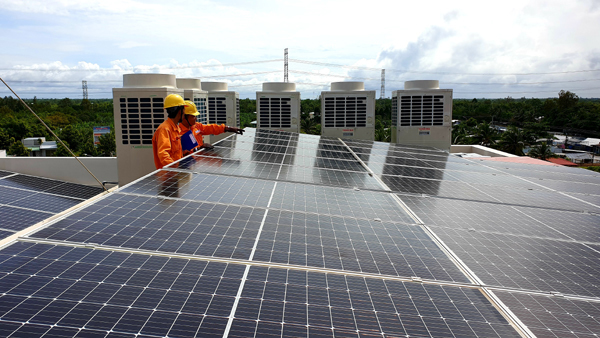“The current electricity system is now quite different,” said Doan Cong Duc, director of PVPower Ca Mau's two gas-fired thermopower plants with the capacity of 750 MW each. He is referring to the appearance of wind and solar power plants in the last two years.

Solar and wind power is the ‘energy of the future’ because it is ‘clean’ and doesn’t pollute the environment. However, one problem exists: heavy rains or typhoons will lead to the interruption of electricity generation, up to thousands of MW within a short period.
Using oil to generate electricity at the two Ca Mau power plants was implemented only in rush hours.
However, this has become more regular for the plants. When solar and wind power systems unexpectedly ‘shut down’, plants like Ca Mau will have to generate electricity to offset the electricity output lost because of the shutdown.
“Hydropower plants are running at full capacity, so the plants like ours have to offset the electricity outage by running with oil,” he explained. “The running with oil just lasts several hours before switching to run with gas."
According to Duc, the two power plants have been alternately running with oil and gas since October 24, and everything has been going smoothly.
However, in order to ensure the electricity generation capacity, the functions of the system need to be examined to ensure the operation capability once every three months.
The two power plants have been running with oil many times and the electricity output generated by firing oil has reached 130 million kwh, higher than initially planned. For Ca Mau Fertilizer Plant, oil-fired electricity costs twice as much as gas-fired (VND2,200-2,500 per kwh).
| Solar and wind power is the ‘energy of the future’ because it is ‘clean’ and doesn’t pollute the environment. However, one problem exists: heavy rains or typhoons will lead to the interruption of electricity generation, up to thousands of MW within a short period. |
Energy experts have talked about the ‘volatility’ of solar and wind power. The Electricity Regulatory Authority (A0) has shown diagrams about the fluctuations of the solar power supply. Just one cloud is enough to lead to an interruption of electricity generation, and other sources of electricity must be mobilized to ensure a stable electricity supply.
Environmentalists have recently organized propaganda campaigns calling on to eliminate ‘dirty energy’.
However, many energy experts pointed out that solar and wind won’t be able to completely replace traditional power. When storms come, blades will have to stop, or they will cause problems to power poles.
Balancing power sources
Do Duc Quan, deputy director of the Department of Electricity and Renewable Energy, said that just within two years, the number of solar power projects put into operation has increased from several projects to 100 with the capacity increasing from hundreds of MW to 5,829 MW.
With the boom, solar power now accounts for 9 percent of total capacity of the total power system instead of 1 percent as seen previously.
Experts predict that the figures will increase rapidly in the time to come as more projects have been licensed.
To date, 187 wind power projects with the total capacity of 11,687 MW and 137 solar power projects with total capacity of 13,618 MW has been added to the national power development plan.
At least 312 wind power projects with total capacity of 78,035 MW and 331 solar projects with total capacity of 36,581 MW are being proposed.
A report of the National Assembly’s Economics Committee on solutions to electricity development by 2030 pointed out that the electricity system integrates a large number of unstable power sources such as wind and solar power.
It is necessary to build backup power sources, which will lead to an increase in investment for the system.
Meanwhile, the electricity transmission projects to help release the capacity of wind and solar power projects in some localities have been going slowly.
According to the Economics Committee, the electricity prices from renewable power sources are higher than from traditional power sources (thermopower and large-scale hydropower).
Electricity of Vietnam (EVN) has been assigned by the State to buy all the electricity output from renewable power projects at prices set by the State.
Once the proportion of renewable power is higher, the average electricity production cost will be higher. As such, each power source has both advantages and disadvantages.
Luong Bang

Rooftop solar power popular in southern provinces
According to the Electricity of Vietnam (EVN), the total capacity of rooftop solar power projects in southern provinces now makes up 60 percent of its total solar power capacity nationwide.

Vietnam has great potential for wind power
Around 10 gigawatts of offshore wind power could be in operation in Vietnam by 2030, according to studies carried out by the Danish Energy Agency and the World Bank.
